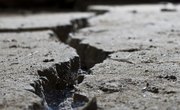
An estimated 7.5-magnitude earthquake shocked and rattled residents of New Madrid, Missouri, on Dec. 16, 1812, leaving behind many cracks, or fractures, in the ground. A fracture in geologic terms is a broken part of the Earth’s crust. Fractures can be as small as a cracked boulder or as large as a continent. They can be caused by weathering, pressure or movements of the Earth’s crust. Depending on the size, how the fracture occurs and the brittleness of the geologic formation, fractures can be organized into several categories.
Joint Fractures
Joints are a fracture where the rock breaks but doesn’t move. Joint fractures can be systematic, or straight and regular, or nonsystematic, which are irregular. Sheet or exfoliation joints are curved fractures that occur in extrusive volcanic rock. Extrusive rocks form from magma cooled slowly deep within the Earth. Columnar joints are fractures that isolate polygon-shaped columns of rock. Joints can be very small or they can be tectonic, running across a large region.
Tensile Fractures
A tensile fracture occurs when the edges pull apart as pressure is applied. Tensile fractures occur in brittle rocks that don’t have much ability to bend or fold when a force is applied. The break in the rock runs perpendicular to the pressure that is applied. To visualize this, imagine holding a cracker on the edges and snapping it in half. Tensile fractures may not create movement and are often also classified as joints. If the two edges move away from each other, the result is a tensile fault.
Shear Fractures
A fault is a fracture where the two edges move during the fracturing process. Faults tend to be shear fractures where one piece of rock slides against the other. They can be strike-slip faults where the sides of the fracture slide against each other horizontally. They can also be dip-slip faults, where one side of the fracture slides up or down relative to the other. Finally, they can be oblique faults, where both types of movement happen. Shear fractures tend to happen in more ductile rock -- rock that can bend when moved slowly but that breaks under sudden forces.
Tectonic Plates and Fault Lines
Fractures are part of local and regional geology, but the crust of the Earth itself is broken up into a set of plates that touch each other at dynamic joints. The junctures of tectonic plates are where you find earthquake fault lines, volcanic eruptions and mountains being thrust up, among other features. These gaps between the plates are the largest fractures on Earth, and they control the form and movements of the continents.
References
About the Author
Based in Wenatchee, Wash., Andrea Becker specializes in biology, ecology and environmental sciences. She has written peer-reviewed articles in the "Journal of Wildlife Management," policy documents,and educational materials. She holds a Master of Science in wildlife management from Iowa State University. She was once charged by a grizzly bear while on the job.
Photo Credits
Stockbyte/Stockbyte/Getty Images
